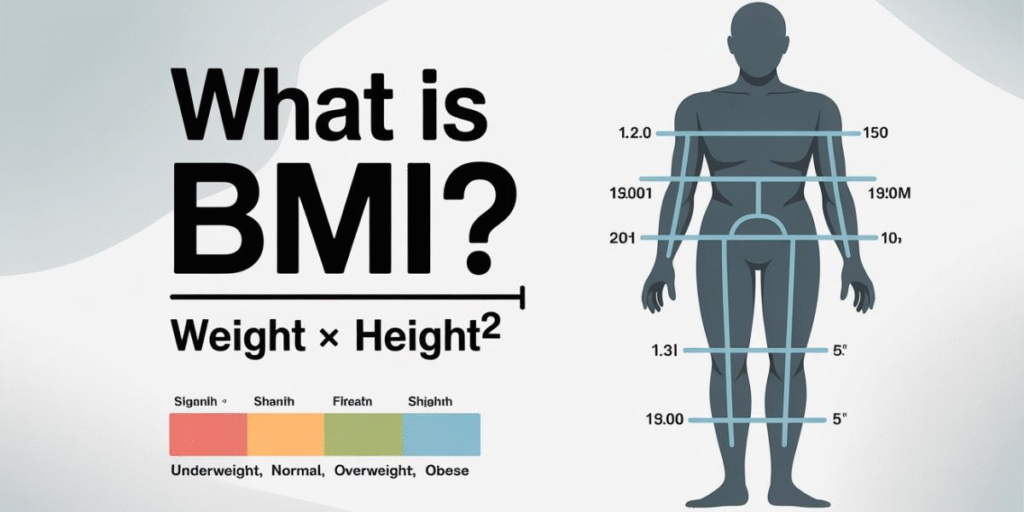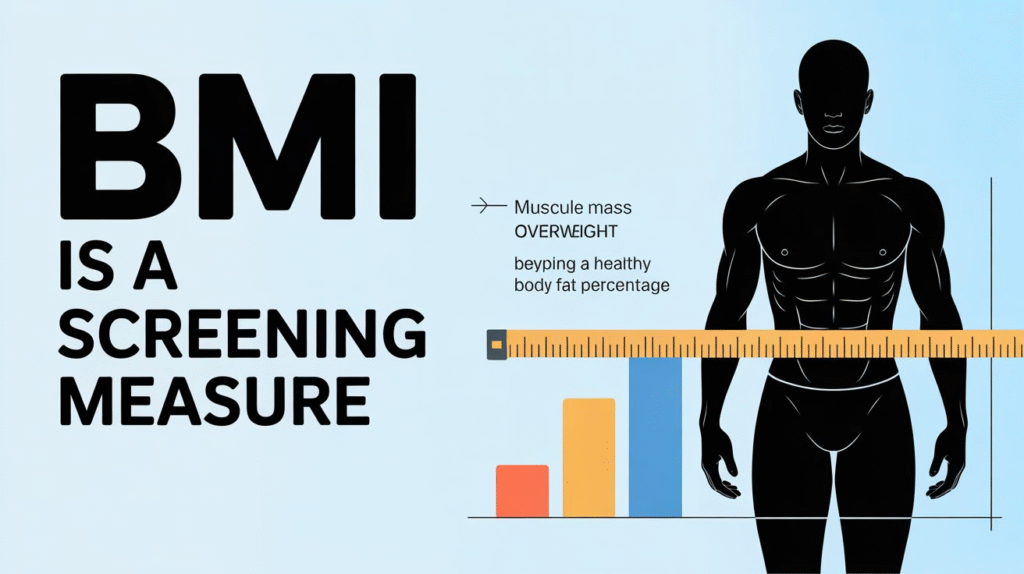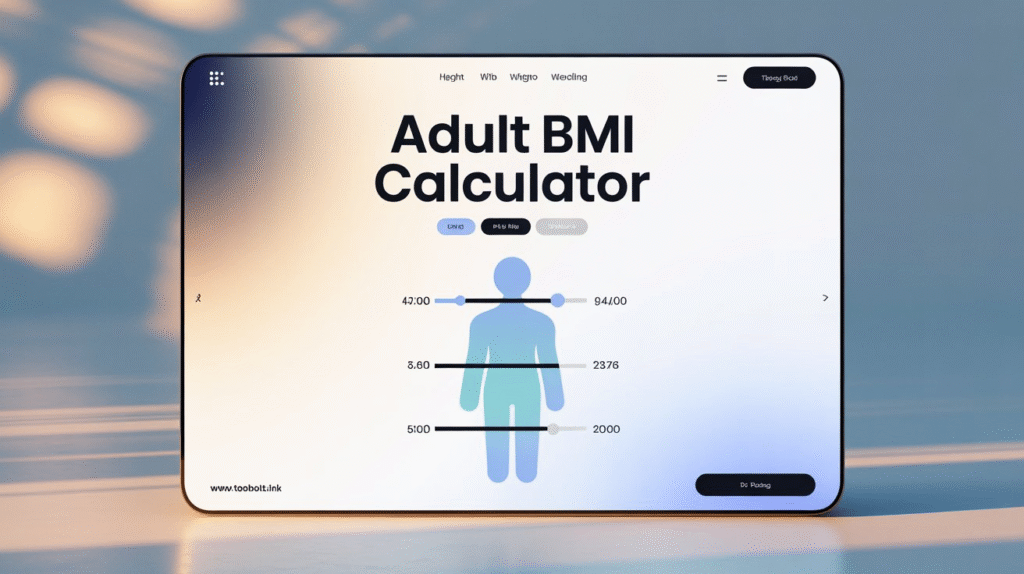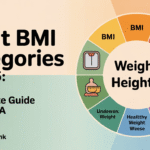Understanding adult BMI categories is more important today than ever in the USA. With rising rates of obesity, people need clear guidance on what their Body Mass Index (BMI) means for health.
The BMI calculation formula is simple, yet it serves as a trusted population health measure. This guide will explain BMI in detail with examples, expert insights, and real-life case studies to help you understand your results.
At a glance

Adult BMI categories divide people into groups like underweight, healthy weight, overweight, and obesity. Each group links to different health risks and outcomes.
Doctors use BMI as a screening measure BMI, not as a final diagnosis, but it helps spot potential issues early.
Here is a simple BMI Range (kg/m²) chart:
| BMI Range (kg/m²) | Category | Health Risk Level |
| Below 18.5 | Underweight | Possible nutritional issues |
| 18.5 – 24.9 | Healthy Weight | Lowest health risk |
| 25 – 29.9 | Overweight | Higher risk of disease |
| 30 – 34.9 | Class 1 Obesity | Moderate risk |
| 35 – 39.9 | Class 2 Obesity | High risk |
| 40 and above | Class 3 Obesity | Severe health risk |
BMI categories for adults
The Body Mass Index (BMI) is a simple formula that divides weight by height squared. For adults, it provides a quick BMI health assessment. Medical providers in the USA rely on these adult BMI categories to plan health care.
Underweight adults may struggle with weak immunity, while overweight and obesity groups face increased risks of chronic disease. Professional medical advice BMI guidance is always needed to understand these results in context.
Must read about: Convert Seconds to Days: The Ultimate 2025 Guide
BMI categories for adults 20 and older
Adults over 20 fall into defined BMI groups used worldwide. According to CDC data, more than 40% of U.S. adults are now classified in Class 1 Obesity, Class 2 Obesity, or Class 3 Obesity (Severe Obesity). This is a growing public health concern.
Here is a weight and height chart for quick reference:
| Height | Underweight (<18.5) | Healthy Weight (18.5–24.9) | Overweight (25–29.9) | Obesity (30+) |
| 5’5” | <111 lbs | 111–149 lbs | 150–179 lbs | 180+ lbs |
| 5’9” | <125 lbs | 125–168 lbs | 169–202 lbs | 203+ lbs |
| 6’0” | <140 lbs | 140–183 lbs | 184–220 lbs | 221+ lbs |
For example, a 5 feet 9 inches BMI example at 180 lbs falls into the overweight range.
BMI is a screening measure

BMI is widely used as a screening measure for BMI, but it cannot capture everything about health. For example, a muscular athlete may score as overweight though their body fat is low.
Experts say, “BMI is useful, but only as part of a bigger picture.” Doctors also check cholesterol, blood pressure, and medical history to give a full BMI health assessment.
Adult BMI example
Take an example of a woman aged 30 who is 5’5’’ tall and weighs 160 pounds. Using the BMI calculation formula, her BMI comes to 26.6. That places her in the overweight range.
This result does not mean she is unhealthy. But it shows a higher chance of developing heart problems or diabetes compared to those in the healthy weight range.
Must read: Tool Calculator – Free Online Calculators for Everyone
Adult BMI calculator

People in the USA often use the CDC Adult BMI Calculator or other adult BMI calculator online tools. These tools are easy and accurate when you enter your weight and height.
Electronic scales for BMI are also popular as they can show both weight and fat percentage. However, online calculators remain the fastest way to measure results without medical devices.
Person-First Language
The medical community promotes Person-First Language obesity to reduce stigma. Instead of saying “an obese adult,” experts prefer “an adult with obesity.” This shows respect and avoids harmful labeling.
Weight bias and stigma create barriers in health care. Using people-first language for health makes it easier for people to seek help without shame.
Explore more
Beyond adult BMI categories, readers can learn about obesity prevention strategies, healthy eating and physical activity, and ways to prevent chronic diseases related to obesity.
Doctors also recommend regular health care provider consultation for maintaining healthy weight and growth. Trusted resources include the and the
On This Page
- At a glance
- BMI categories for adults
- BMI categories for adults 20 and older
- BMI is a screening measure
- Adult BMI example
- Adult BMI calculator
- Person-First Language
- Explore more
Must read about: Tool Converter – Your Free Online Conversion Hub
BMI and Health Conditions
| BMI Category | Common Risk | Possible Conditions |
| Underweight | Low immunity | Anemia, bone loss |
| Healthy | Balanced | Lowest disease risk |
| Overweight | Moderate | Diabetes, heart disease |
| Obesity | High | Stroke, cancer, sleep apnea |
Obesity Classes Explained
| Class | BMI Range | Severity |
| Class 1 | 30–34.9 | Moderate risk |
| Class 2 | 35–39.9 | High risk |
| Class 3 | 40+ | Severe risk |
Example BMI by Height and Weight
| Height | Weight | BMI Score | Category |
| 5’5’’ | 140 lbs | 23.3 | Healthy Weight |
| 5’9’’ | 180 lbs | 26.6 | Overweight |
| 6’0’’ | 240 lbs | 32.5 | Obesity |
10. The Future of BMI in Health Car

In recent years, researchers have started exploring alternatives to BMI. One of these is the Relative Fat Mass Index (RFM), which uses waist circumference as well as height.
Early studies suggest that RFM may give a more accurate picture of fat percentage across different populations.
Technology is also changing how people track their health. New electronic scales for BMI and wearable devices connect directly to health apps.
They track not only BMI but also hydration, muscle mass, and fat levels. This gives individuals a more complete BMI health assessment and helps them make better lifestyle choices.
Must read about: Ultimate Guide to Text Tools: Boost Your Productivity and Creativity
Table: BMI vs RFM Comparison
| Feature | BMI | RFM |
| Formula | Weight ÷ Height² | 64 – (20 × Height ÷ Waist) |
| Measures | Weight to height ratio | Waist to height ratio |
| Accuracy for fat % | Moderate | Higher, especially for women |
| Use in clinics | Very common | Emerging research tool |
FAQs
What is the Body Mass Index (BMI)?
It is a measure of weight compared to height to assess health risk.
Is BMI accurate for everyone?
No, muscular people may appear overweight though they are healthy.
How can I calculate my BMI?
Use the BMI calculation formula or the CDC Adult BMI Calculator online.
hat is a healthy BMI range for adults?
A BMI Range (kg/m²) between 18.5 and 24.9 is considered healthy.
Can BMI predict diseases?
Not directly, but higher BMI links to risks of heart disease, diabetes, and more.
Final Thoughts
Adult BMI categories are useful for understanding weight and health, but they are not the full story. Use BMI as a first step, then combine it with lifestyle changes, medical checkups, and professional advice.
Respectful language and awareness of people-first health approaches help create a healthier society. By learning your BMI and acting early, you can take control of your well-being in 2025 and beyond.

Zain Khan is the creator of Toolbolt.ink, providing fast, easy-to-use online tools for everyday conversions and calculations.




